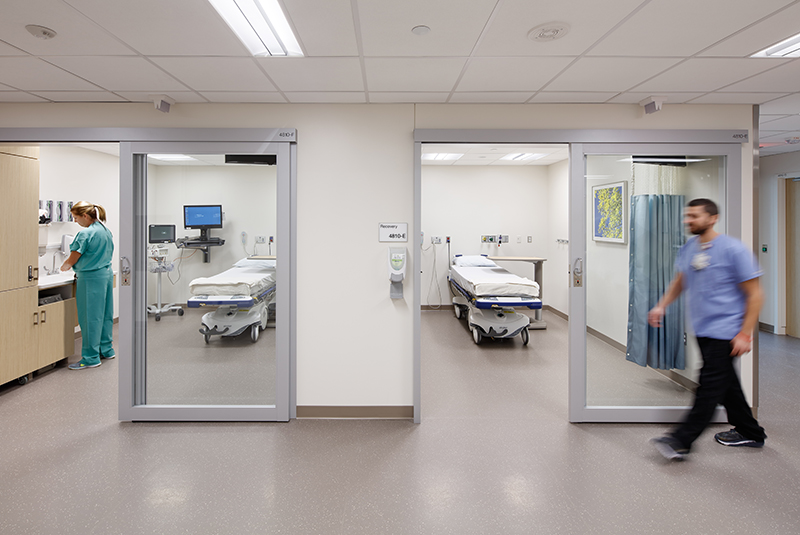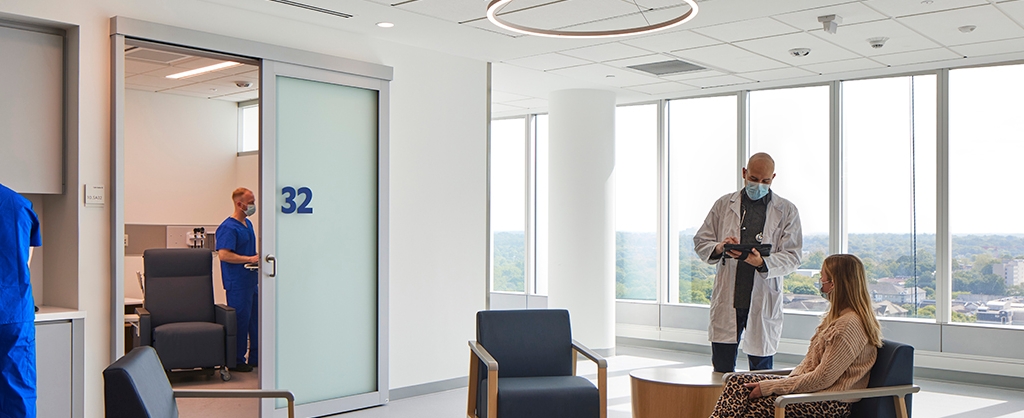
While these considerations are true for nearly every element of the built environment, interior doors represent a means to provide value and to support cost-effective and functional designs. As a repeated feature throughout a health care facility, specifying the right opening solution can help a medical center maximize its functionality, leading to better patient experiences and medical care.
The question is, what is the right door solution for a modern health care facility? Is it a sliding door or a swing door?
Optimizing value with commercial sliding doors
When it comes to opening systems, commercial sliding doors offer multiple benefits. Because they slide along the wall, they eliminate the need to plan for swing arc trajectories, saving up to 30 square feet per door. Their ability to preserve usable square footage allows designers to plan more efficient exam rooms, restrooms and recharge spaces without compromising the functionality of these rooms. Sliding doors can also be extremely effective when a large, clear opening is desired, but a large swing door would be obtrusive or difficult to manage.
Likewise, sliding doors can support multiple types of flexibility. Because they slide, they can open corridor space to provide storage area during unforeseen waves of patients—a design that has become more prominent in the years after 2020. Sliding doors can also be specified in larger-than-average sizes to allow two adjacent spaces to operate as one large room when necessary. When these systems offer premium acoustic performance, they can help occupants maintain privacy and concentration during solo work.
While sliding doors provide several points of value to a building’s interior, there may be instances where their use is prohibited by code, specifically if a door is needed to swing outward from the door frame, generally for egress or urgent access in health care settings.
Flexible swinging doors offer different performance characteristics
Swinging doors commonly offer a fixed opening width and necessitate space to accommodate swing arc trajectories as well as the approach and maneuvering clearances listed in the Americans with Disability Act (ADA) standards. Traditional swinging doors often cannot contribute the same flexibility as sliding doors, but there are options on the market that preserve flexibility.
Swinging doors that have an auxiliary leaf can provide a standard opening size for day-to-day operation. When staff need to move large equipment or patient beds, they can open the auxiliary leaf to widen the opening. This helps spaces adapt more easily to changes in occupant need—whether that is bringing care to a patient or a patient to specific equipment.
Going beyond an either-or approach
Swinging doors and sliding doors offer different benefits to health care facilities, but project stakeholders do not need to take an either-or approach when choosing the doors systems for their buildings. Blending both options throughout a building’s interior can help meet design intent as well as building code and accessibility requirements.
With this approach, when specifiers choose door systems from the same manufacturer, they can simplify the specification process as well as streamline the logistics and installation of these door systems. Further, because both types of door may have similar component parts, it will help create a more standardized maintenance program, to support cost-effective operation.
Sliding doors and swinging doors support modern health care design
Modern health care design depends on several different factors—from location and building type to the modes of care provided. While designers have multiple ways to plan facilities that remain viable for the long-term, interior doors can be an effective, low-risk means for improving functionality and accessibility.
Door manufacturers with a proven track record of providing several types of flexible opening systems can help health care designers and end-users maximize the benefits these systems provide. As such, selecting the right door manufacturer can be as important as selecting the right door type.







